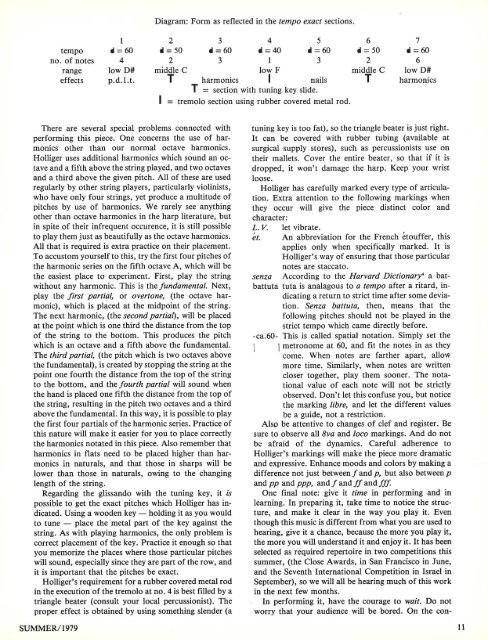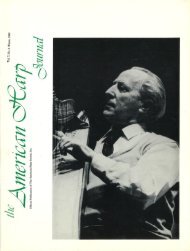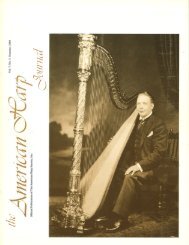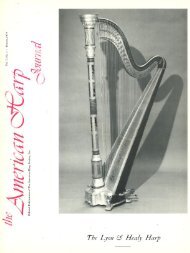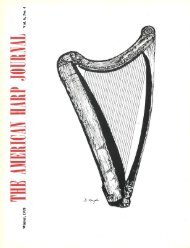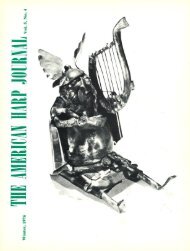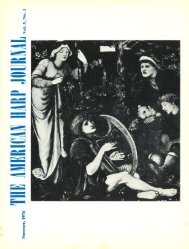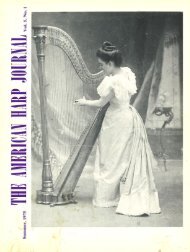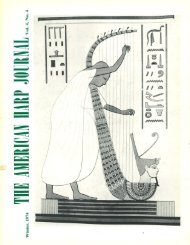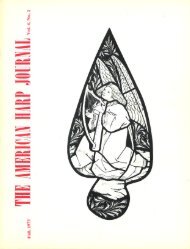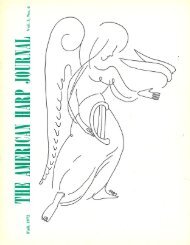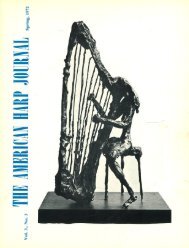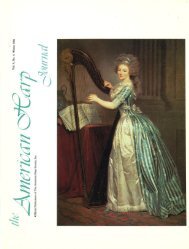AHJ, Vol. 7 No. 1, Summer 1979
AHJ, Vol. 7 No. 1, Summer 1979
AHJ, Vol. 7 No. 1, Summer 1979
You also want an ePaper? Increase the reach of your titles
YUMPU automatically turns print PDFs into web optimized ePapers that Google loves.
Diagram: Form as reflected in the tempo exact sections.<br />
I 2 3 4 5 6 7<br />
tempo •=60 a= 50 a= 60 •=40 a= 60 a= 50 •=60<br />
no. of notes 4 2 3 I 3 2 6<br />
range low D# middle C low F middle C low D#<br />
p.d.1.t.<br />
T = section with tuning key slide.<br />
= tremolo section using rubber covered metal rod.<br />
effects T harmonics I nails T harmonics<br />
There are several special problems connected with<br />
performing this piece. One concerns the use of harmonics<br />
other than our normal octave harmonics.<br />
Holliger uses additional harmonics which sound an octave<br />
and a fifth above the string played, and two octaves<br />
and a third above the given pitch. All of these are used<br />
regularly by other string players, particularly violinists,<br />
who have only four strings, yet produce a multitude of<br />
pitches by use of harmonics. We rarely see anything<br />
other than octave harmonics in the harp literature, but<br />
in spite of their infrequent occurence, it is still possible<br />
to play them just as beautifully as the octave harmonics.<br />
All that is required is extra practice on their placement.<br />
To accustom yourself to this, try the first four pitches of<br />
the harmonic series on the fifth octave A, which will be<br />
the easiest place to experiment. First, play the string<br />
without any harmonic. This is the fundamental. Next,<br />
play the first partial, or overtone, (the octave harmonic),<br />
which is placed at the midpoint of the string.<br />
The next harmonic, (the second partial), will be placed<br />
at the point which is one third the distance from the top<br />
of the string to the bottom. This produces the pitch<br />
which is an octave and a fifth above the fundamental.<br />
The third partial, (the pitch which is two octaves above<br />
the fundamental), is created by stopping the string at the<br />
point one fourth the distance from the top of the string<br />
to the bottom, and the fourth partial will sound when<br />
the hand is placed one fifth the distance from the top of<br />
the string, resulting in the pitch two octaves and a third<br />
above the fundamental. In this way, it is possible to play<br />
the first four partials of the harmonic series. Practice of<br />
this nature will make it easier for you to place correctly<br />
the harmonics notated in this piece. Also remember that<br />
harmonics in flats need to be placed higher than harmonics<br />
in naturals, and that those in sharps will be<br />
lower than those in naturals, owing to the changing<br />
length of the string.<br />
Regarding the glissando with the tuning key, it is<br />
possible to get the exact pitches which Holliger has indicated.<br />
Using a wooden key - holding it as you would<br />
to tune - place the metal part of the key against the<br />
string. As with playing harmonics, the only problem is<br />
correct placement of the key. Practice it enough so that<br />
you memorize the places where those particular pitches<br />
will sound, especially since they are part of the row, and<br />
it is important that the pitches be exact.<br />
Holliger's requirement for a rubber covered metal rod<br />
in the execution of the tremolo at no. 4 is best filled by a<br />
triangle beater (consult your local percussionist). The<br />
proper effect is obtained by using something slender (a<br />
tuning key is too fat), so the triangle beater is just right.<br />
It can be covered with rubber tubing (available at<br />
surgical supply stores), such as percussionists use on<br />
their mallets. Cover the entire beater, so that if it is<br />
dropped, it won't damage the harp. Keep your wrist<br />
loose.<br />
Holliger has carefully marked every type of articulation.<br />
Extra attention to the following markings when<br />
they occur will give the piece distinct color and<br />
character:<br />
L. V. let vibrate.<br />
et. An abbreviation for the French etouffer, this<br />
applies only when specifically marked. It is<br />
Holliger's way of ensuring that those particular<br />
notes are staccato.<br />
senza According to the Harvard Dictionary 4 a batbattuta<br />
tuta is analagous to a tempo after a ritard, indicating<br />
a return to strict time after some deviation.<br />
Senza battuta, then, means that the<br />
following pitches should not be played in the<br />
strict tempo which came directly before.<br />
-ca.60- This is called spatial notation. Simply set the<br />
I metronome at 60, and fit the notes in as they<br />
come. When notes are farther apart, allow<br />
more time. Similarly, when notes are written<br />
closer together, play them sooner. The notational<br />
value of each note will not be strictly<br />
observed. Don't let this confuse you, but notice<br />
the marking Libre, and let the different values<br />
be a guide, not a restriction.<br />
Also be attentive to changes of clef and register. Be<br />
sure to observe all Bva and loco markings. And do not<br />
be afraid of the dynamics. Careful adherence to<br />
Holliger's markings will make the piece more dramatic<br />
and expressive. Enhance moods and colors by making a<br />
difference not just between f and p, but also between p<br />
and pp and ppp, and f and ff and fff<br />
One final note: give it time in performing and in<br />
learning. In preparing it, take time to notice the structure,<br />
and make it clear in the way you play it. Even<br />
though this music is different from what you are used to<br />
hearing, give it a chance, because the more you play it,<br />
the more you will understand it and enjoy it. It has been<br />
selected as required repertoire in two competitions this<br />
summer, (the Close Awards, in San Francisco in June,<br />
and the Seventh International Competition in Israel in<br />
September), so we will all be hearing much of this work<br />
in the next few months.<br />
In performing it, have the courage to wait. Do not<br />
worry that your audience will be bored. On the con-<br />
SUMMER/ <strong>1979</strong><br />
11


